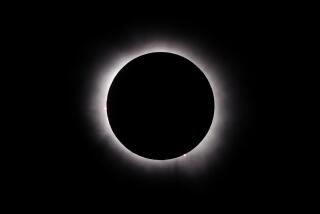Solar Eclipse Mesmerizes Millions in Asia : Phenomenon: From Iran to the Pacific, moon’s shadow darkens Earth. Some see it as divine event. For others it’s cause of fear.
- Share via
NEW DELHI — It was only 8:15 a.m., but the sky was darkening and birds were winging back to their nests. Elderly Hindu priest Sooalal hurried to light the sacred fire.
“The sun is suffering, and being troubled by demons,” explained the barefoot pandit. “We are doing this to soothe its soul.”
Within minutes, the priest and a circle of fellow Brahmans had a roaring fire going on the indoor hearth at New Delhi’s Birla Temple and, to the drone of divine chants, were tossing handfuls of roots, herbs, nuts, rice, sugar, coconut, dried fruits and millet into the crackling flames to restore the natural order of things.
On Tuesday morning, a total eclipse of the sun sent the moon’s shadow racing across 8,600 miles of Asia, from south of the Iranian capital, Tehran, to the island-dotted waters of the Pacific Ocean.
Millions on the continent scanned the skies or watched TV broadcasts of the spectacular celestial event, while others, much like their ancestors, fretted that the rare darkening of the heavens during daytime might presage an earthly calamity.
In mostly Muslim Bangladesh, for instance, many people remained indoors, and pregnant women were especially careful, fearing that exposure to the eclipse might cause fetal deformities or miscarriage.
In recent weeks, inhabitants of predominantly Buddhist Thailand, which like the rest of Southeast Asia experienced its last total eclipse of the sun in 1955, had been busily burning black incense and offering eight kinds of black foods to appease the angry god that ancient myths blame for eclipses.
Rahu, a fierce, four-armed dragon-tailed titan whose symbolic color is black, burns for vengeance against the righteous gods and traverses the heavens in his eight-horse chariot trying to devour the sun and the moon, it is said.
In New Delhi and Bombay, India’s major western seaport, the streets were eerily deserted Tuesday morning as millions of people stayed indoors. At the same time, in Kurukshetra, north of New Delhi, as many as 1 million pilgrims bathed in the sacred waters of two side-by-side lakes--a rite considered especially holy during eclipses--and chanted hymns, blew conch shells and rang bells.
In Agra, where the eclipse was partial, hundreds of tourists watched the fabled white-marble Taj Mahal slowly take on a steely gray luster in the dimming light.
*
Along a 25-mile-wide path that ran south of New Delhi and Calcutta in India and north of Bangkok in Thailand, Phnom Penh in Cambodia and Ho Chi Minh City in Vietnam, the eclipse was total, with the disc of the moon blocking out the entire sun. In the small eastern town of Diamond Harbour near Calcutta, where the eclipse lasted the longest in India at 77 seconds, about 200,000 people came to watch.
In Cambodia, at the fabled temples of Angkor Wat, thousands of soldiers stood guard against possible attacks by Khmer Rouge guerrillas as Cambodians and an estimated 2,000 foreign visitors watched the sun vanish against the magnificent backdrop of the 12th-Century edifices.
In Vietnam, thousands of people wearing sunshades thronged to beaches in the normally tranquil fishing port of Phan Thiet, about 90 miles east of Ho Chi Minh City. Bangkok, Thailand’s capital, experienced partial darkness, and the city’s traffic, always maddeningly slow, ground to a near-halt as motorists peered at the sky.
More to Read
Sign up for Essential California
The most important California stories and recommendations in your inbox every morning.
You may occasionally receive promotional content from the Los Angeles Times.













